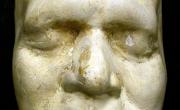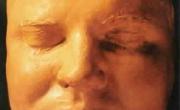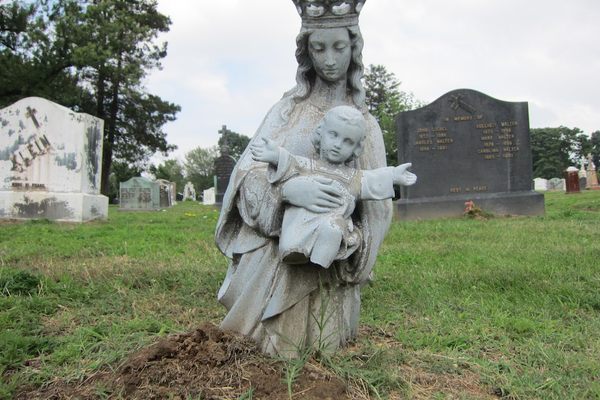Morbid Monday: The Face of the Emperor
Napoleon on his death bed, painted by Horace Vernet (1826) (via Wikimedia)
Napoleon Bonaparte spent the last six years of his life in exile on the incredibly remote island of St. Helena, writing his memoirs and complaining about his English caretakers. When he finally succumbed to death — of stomach cancer or something more insidious — his doctors got busy shaving his head so that his hair could be sent to his family as a memento, and preparing plaster for a death mask.
Taking a final impression of the face of a dead loved one or emperor has a long and interesting history dating all the way back to the Middle Ages. Emerging more or less at the same time as the cadaver tomb, death masks served as a way to preseve the likeness of the dead long after the body has returned to dust. The tradition of making a death mask has lasted though to the modern day. The emergence of photography, especially post-mortem photography, began to erode the popularity, replacing the need for one last three dimensional reminder of the dead with albums of photos.
Thousands of death masks exist in collections all over the world, including two notable large collections at Princeton University and in Kiev, Ukraine. Today, the intrepid traveler can get up close to the faces of Benjamin Franklin, Dante Alighieri, Oliver Cromwell and Nikola Tesla, amongst many, many others. Not a lot of ladies represented, however the death mask of a particularly lovely drowning victem is even said to have been the inspiration for modern CPR dummies. The mask of Abraham Lincoln with — what appears to be — his eyeballs gouged out is particularly, uh, striking.
Death mask of Abraham Lincoln, 1917 photograph (via Internet Archive)
Napoleon’s death mask, 1937 photograph (via Library of Congress)
Following Napoleon’s death, demand for his uncommonly life-like, and, dare we say, rather handsome, deathly visage was high. Reproductions of the cast made by his attending doctors were copied, and copied again. As a result, there are many questions about the authenticity of the masks, up to and including controversy over whether it is even the face of the emperor at all. Today Napoleon’s death mask can bee seen in museums from North Carolina to Liverpool, Paris to Havana, Cuba.
FACES OF DEATH
 |
LAURENCE HUTTON COLLECTION OF LIFE AND DEATH MASKS One man’s lifelong obsession with death
|
 |
ONE STREET MUSEUM DEATH MASK COLLECTION The largest collection of death masks in Ukraine.
|
Join us each Monday on Twitter and follow our #morbidmonday hashtag, for new odd and macabre themes each week: Atlas Obscura on Twitter
PREVIOUSLY:
Morbid Monday: Triumph of Life: Plague Columns
Morbid Monday: Exquisite Corpses: The Art of the Cadaver Tomb
Morbid Monday: Fifteen Planes Enter, Two Planes Leave: The Deadly Dole Air Race
Morbid Monday: Ghost Writing: The Story of Pearl & Patience
Morbid Monday: Phineas Gage: Jerk












Follow us on Twitter to get the latest on the world's hidden wonders.
Like us on Facebook to get the latest on the world's hidden wonders.
Follow us on Twitter Like us on Facebook